Want to jump straight to the best webinar software? The best webinar software for most is Livestorm or WebinarJam.
Eight weeks. That’s how long the Quick Sprout team spent researching the best webinar software. We analyzed 384 reviews to identify recurring themes, analyze customer sentiment, determine ease of use, assess reliability, and evaluate the level of customer support. We also scrutinized each company across 27 criteria points.
Our first round identified 28 potential best webinar brands. The second round cut this number down to 20. Our final round narrowed down the top 14 webinar software brands.
The Top 14 Best Webinar Software Brands
The best webinar software brand for the majority of our readers is Livestorm. This software makes it easy for you to invite attendees, engage your viewers with an array of interactive tools, and analyze registration, attendance, and audience participation when you’re done. Try Livestorm for free today.
- Livestorm – Best all-in-one-combo of webinars and virtual meetings
- WebinarJam – Best for hosting all types of webinars
- ClickMeeting – Best for beginners
- Demio – Best for marketing and sales
- Webex – Best for hosting accessible webinars
- BlueJeans – Best for scaling live webinars beyond 500 attendees
- EverWebinar – Best set-it-and-forget-it webinars
- Vast Conference – Best budget-friendly option
- Zoom – Best for educational institutions
- BigMarker – Best for large virtual events
- Crowdcast – Best webinar platform for a built-in audience
- GoTo Webinar – Best for infrequent webinars
- MyOwnConference – Cheapest way to facilitate simultaneous webinars
- WebinarGeek – Best for GDPR compliance and/or EU audiences
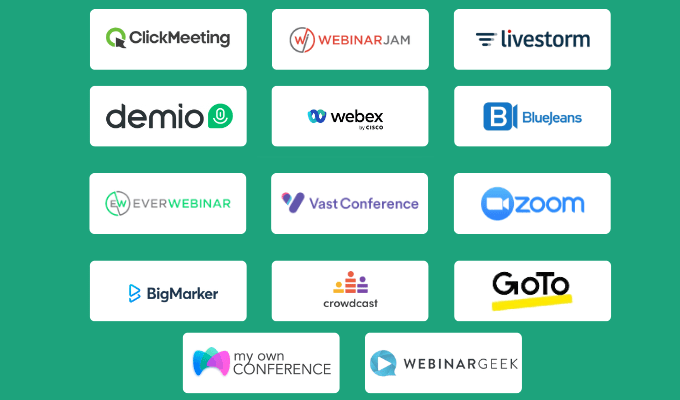
How We Evaluated the Best Webinar Companies
We did some heavy legwork to determine the best webinar software options so that you don’t have to. Here’s a breakdown of how we decided which brands made the cut. (If you’re on a tight schedule, you can jump straight to the product reviews.)
How We Qualify Webinar Providers for Consideration
We scoured the web and narrowed our initial pool of choices down to 28 brands that offer webinar services:
Adobe Connect, BigMarker, BlueJeans, ClickMeeting, Crowdcast, Dacast, Demio, EasyWebinar, EverWebinar, Flow, GetResponse, GoTo Webinar, Intermedia AnyMeeting, Livestorm, Livestream, LiveWebinar, Microsoft Teams Webinar, MyOwnConference, RingCentral Webinar, Riverside, Vast Conference, Webex, WebinarGeek, WebinarJam, WebinarNinja, WebinarsOnAir, Zoho Meeting, Zoom.
Several of these brands weren’t good enough to make the second cut. How did we figure that out?
We evaluated each brand according to seven core criteria points:
- Accessibility: We cut companies that required attendees to download software onto their own devices and nixed software that didn’t work seamlessly on both mobile and desktop options. On the other hand, brands that fulfilled these requirements and provided users with automated closed captioning, translations, and compatibility with screen readers were moved up on our list.
- Audience engagement: If brands didn’t have tools to facilitate audience interaction, such as polls, chat-based Q&A, upvoting questions, file sharing, hand raising, and post-webinar surveys, we removed them from the list. No matter what type of webinar you’re running, meaningful audience engagement is essential.
- Marketing customization: For this criteria point, we considered how easy it was for users to customize landing pages, registration forms, webinar rooms, waiting rooms, and automated email notifications with their company’s logo, colors, and branding. Did the software allow for a seamless, branded experience, or did the software distract from the user’s brand?
- Moderator capabilities: Successful webinar software gives moderators control over the webinar so the host can focus on speaking. Moderators should be able to kick attendees out if needed, invite attendees to speak, screen share, mark chats as questions, answer questions, share files, and play videos with ease.
- Recording capabilities: Quality webinar services allow users to record webinars for future use. If the software didn’t have the option to record, ample storage space, and the capability to edit videos, we rejected it.
- Support: Nothing is worse than a technology glitch in the middle of a webinar, but it happens. We kept software brands that provided quick response times, a range of support options—such as phone, chat, and ticket—and the opportunity to purchase live tech support for big events.
- Webinar type: There are many ways to host a webinar, and the software you use should reflect that. If brands didn’t offer a variety of formats, such as live, hybrid, just-in-time, and automated, we took them off our list. Brands with the option to host paid webinars, recurring webinars, and webinar series earned extra points in our book.
We also eliminated any brand that was:
- A streaming software tool
- A UCaaS solution with a long list of other features
- Not primarily focused on webinars
- A beta webinar product, or one that no longer exists
Of the 28 brands, we rejected 28.6% according to these qualifications and criteria.
Once we narrowed our list down according to the criteria above, we had 20 options left.
We dug deep into each one of these companies to find out which ones provide optimal services.
How We Narrowed the List of Qualified Webinar Software Tools
Our research team cut software that technically qualified according to our criteria but offered fewer features than similar choices. We also eliminated software with few or no reviews, along with software that came with an abundance of negative feedback.
Finally, we turned down brands that offered software solely for big virtual events or only provided enterprise-grade solutions. Here’s our list of webinar software that qualified but isn’t recommended:
Adobe Connect: Adobe’s webinar software is a lot more expensive than other offerings, and it’s complicated and confusing to set up. With a focus on academic and educational webinars only, it also lacks versatility.
EasyWebinar: A decent offering with a bright, user-friendly interface, EasyWebinar might have made our list if it didn’t have many reviews detailing its terrible customer support.
LiveWebinar: While this option offers flexible choices for hosting several types of webinars, along with solid audience engagement features, our team found that many of these were paid add-ons, inflating the price of this software. Reviewers also noted Livewebinar’s nonintuitive, confusing UI.
Microsoft Teams Webinar: On the surface, this software meets our qualifications, and Microsoft Teams is immensely popular. But the webinar feature is so new that few customers have reviewed it, meaning the market hasn’t tested this one out enough for us to recommend it.
WebinarNinja: This company appears to be relatively small, which may be part of why several reviewers reported that it struggles to provide adequate customer support. Simply put, there are better options on the market.
Zoho Meeting: If you already use other Zoho products, you’ll find that Zoho Meeting is an easy way to host and produce webinars. Otherwise, this software is missing some core features that other brands have natively integrated, so you’re most likely better off with another choice.
The Top Webinar Companies Left Standing
After eliminating 14 brands, we found that the remaining 50% of our original 28 choices made the cut. Livestorm works the best for most users, with software that makes it easy to invite attendees, engage viewers, and analyze important statistics.
- Livestorm – Best all-in-one-combo of webinars and virtual meetings
- WebinarJam – Best for hosting all types of webinars
- ClickMeeting – Best for beginners
- Demio – Best for marketing and sales
- Webex – Best for hosting accessible webinars
- BlueJeans – Best for scaling live webinars beyond 500 attendees
- EverWebinar – Best set-it-and-forget-it webinars
- Vast Conference – Best budget-friendly option
- Zoom – Best for educational institutions
- BigMarker – Best for large virtual events
- Crowdcast – Best webinar platform for a built-in audience
- GoTo Webinar – Best for infrequent webinars
- MyOwnConference – Cheapest way to facilitate simultaneous webinars
- WebinarGeek – Best for GDPR compliance and/or EU audiences
Match Your Scenario to the Right Webinar Solution
Our 14 top webinar software options fit a variety of needs, but we’ve done the work of sorting the options according to different scenarios. This makes it easier for you to choose which option suits your brand best. Here are five scenarios we found particularly helpful to consider:
- You want to try running webinars for the first time
- You want to host internal all-hands meetings
- You want to make money selling webinars
- You’re on a really tight budget
- You’re a university or educational institution
You Want to Try Running Webinars For The First Time
Best option: Livestorm
We love that Livestorm offers five webinar types, a feature that makes it ideal for anyone trying webinars for the first time. You won’t have to choose just one or two types. Try them all and see which one fits your needs best.
Livestorm also places a strong focus on accessibility, integrations, and audience engagement features. Whether you’re a seasoned webinar host or are just starting out, you’ll appreciate Livestorm’s intuitive scheduling and recording storage capacity. Livestorm offers a 30-day free trial.
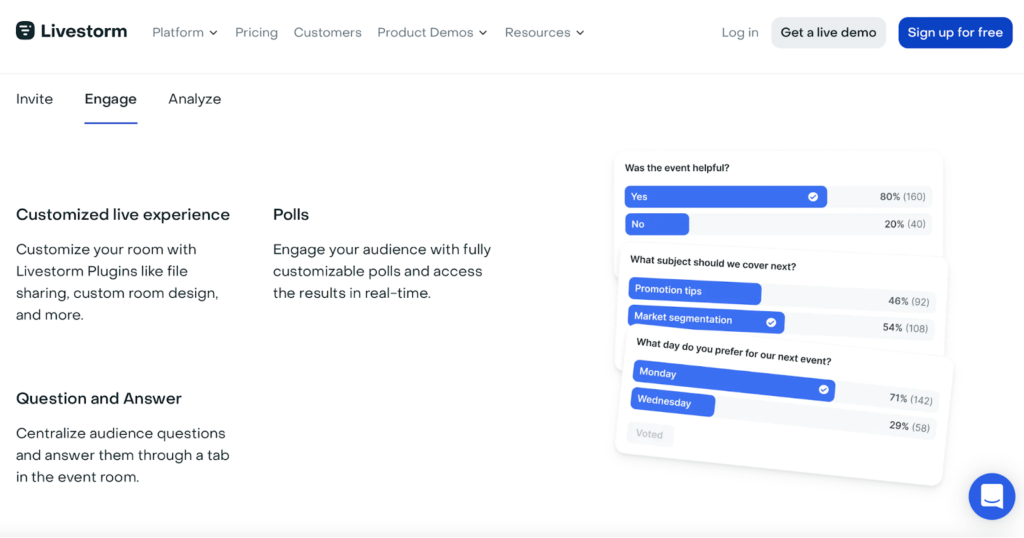
Another great choice: ClickMeeting
Coming in right behind Livestorm for offering ideal software for beginners, ClickMeeting lets you pre-load content before each webinar and comes with a suite of audience interaction tools. ClickMeeting gives you the option to host all webinar types except just-in-time, and it comes with lots of recording storage and easy-to-use scheduling software.
If you’re just starting out in the world of webinars, make sure you pay attention to:
- Pricing: how much are you willing to shell out when you’re learning how to maximize webinars for your brand?
- Audience engagement: what tools does the program give you to encourage meaningful input from your audience?
- User satisfaction: Always check user reviews before committing to a product. Seek out bad reviews as well as good ones to get the full picture.
- Scheduling: Webinar software should make scheduling easy, especially for beginners.
- Pre-loading content: does the software allow you to upload files and videos before your webinar session to help make the event run smoothly?
- Recording capabilities: can the software record your events, and if so, how much space does it have for storing these recordings?
- Webinar type: How many of the five webinar types does the software allow you to run?
You Want to Host Internal All-Hands Meetings
Best option: Livestorm
Building a brand is important not only for customers but also for employees, and Livestorm shines at this. It allows you to customize most facets of the webinar software, offers 39 integrations with other tools you’re probably using, and comes with unlimited storage for webinar recordings.
Automated closed captioning makes it accessible to most, and attendee analytics help you see who attended and when.
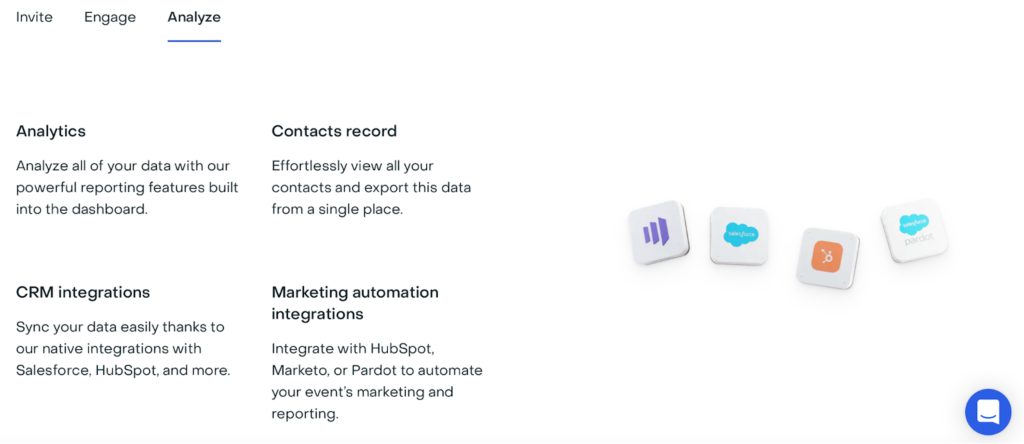
Another great choice: BlueJeans
Like Livestorm, BlueJeans offers closed captioning, making it accessible for your team, as well as analytics to help you see who participated. BlueJeans does not facilitate automated, hybrid, or just-in-time webinars, but reviewers praise its reliability. The software allows for screen sharing and comes with unlimited storage space to keep a copy of all your daily meetings.
When you’re searching for the right webinar software for keeping your team informed and engaged, pay attention to:
- Reliability and performance: When you’re using the same software day after day, you’ll want it to run with minimal glitches and issues.
- Scheduling: Can the software easily schedule your meetings with attendees in different time zones?
- Breakout rooms: does the software give attendees the option to gather in smaller virtual rooms to collaborate, study, network, and problem-solve during a webinar?
- Password protection: To keep unwanted attendees out, seek out webinar software that creates a unique password for all attendees, or even better, a personalized code for each person.
- Recording capabilities: Looking back at previous meetings can be helpful for you and your team. Does the software you choose allow you to record, store, and edit meetings for future use?
- Immersive screen sharing: Does the program enable you to overlay your webcam, give attendees the ability to control your screen, and let you show more than one screen at once?
You Want to Make Money Selling Webinars
Best option: WebinarJam
If you’re creating valuable webinars that people pay for, integration with a payment system is a must. WebinarJam—and its sister site, EverWebinar—works with payment systems like PayPal, Stripe, Kartra, and just about any payment processing software on the market.
Branding is crucial if you’re selling webinars, and WebinarJam allows you to customize CTA buttons, registration forms, and emails. Plus, WebinarJam records every part of your webinar, including the live chat section. This allows the software to replicate each aspect of a webinar in the replay, giving it a live feel.
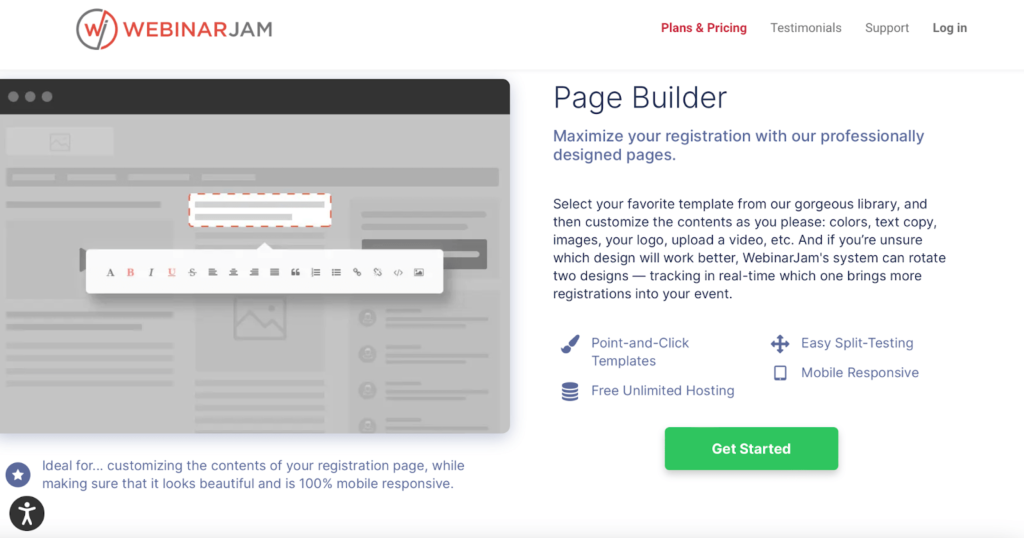
Another great choice: ClickMeeting
Unlike WebinarJam, ClickMeeting only integrates with PayPal, but this is more than other choices offer when it comes to payment processing integration. This integration makes it so that Webinar attendees only need to pay the PayPal fees—they won’t get any extra fees from ClickMeeting.
ClickMeeting also lets you customize emails, registration pages, and CTAs. Its recording capabilities help you transform your recordings into recurring, on-demand, hybrid, automated, and paid webinars.
When you’re testing out different options for paid webinars, pay attention to:
- Payment and processing fees: is payment processing built into the software, or do you have to use Zapier and integrations to take payment from attendees? What fees do you or attendees have to pay?
- Marketing customization: Branding is especially important for paid webinars. How much of the software is customizable? Where can you insert your brand?
- Calls to action: does the software allow you to create bright, engaging CTAs to help turn webinar attendees into regular customers?
- Recording capabilities: how much recording space does the software have? Does it allow you to edit webinars and create high-quality recordings?
- Webinar types: how many of the five webinar types does the software allow you to create?
You’re on a really tight budget
Best option: Vast Conference
Let’s face it: the economy can be a rollercoaster. If you don’t want to drop big bucks on webinar software but still need a high-quality program, Vast Conference offers an entry-level plan that’s four times less expensive than other choices on our list.
This brand has ideal pricing for small teams but is capable of scaling up to 100 attendees in the next pricing tier, which costs just a few dollars more per month.

Another great choice: MyOwnConference
We love that MyOwnConference offers a free plan. Not only that, but the free version gives users access to many of the features MOC also offers paying customers, including simultaneous webinars and unlimited broadcasters per webinar. The attendee limit for the free plan is 20 people.
MyOwnConference offers a range of payment tiers based on one-time, annual, monthly, and even daily payments. You can also choose a pricing tier based on how many attendees you’d like to host.
If you’re looking for the least expensive software out there, consider:
- Pricing: because let’s face it, when you’re on a budget, price matters more than anything. Does the software have a free or super low-cost plan that offers what you need? Are the paid plans reasonably priced and budget-friendly?
You’re a University or Educational Institution
Best option: Zoom
Thanks to the COVID-19 pandemic, virtually everyone knows how well Zoom works to support remote learning. When we put Zoom through our rigorous tests, we found that no other brand could compare to Zoom’s usefulness as an educational tool. Zoom has 99 integrations, including many top education software offerings.
Zoom is accessible, user-friendly, and flexible. A second-grade teacher can use Zoom to host an art class for a group of kids as easily as a physics professor can create a complex lecture for college students. With plenty of audience engagement features, screen sharing, and mobile compatibility, Zoom is ideal for students and educators everywhere.
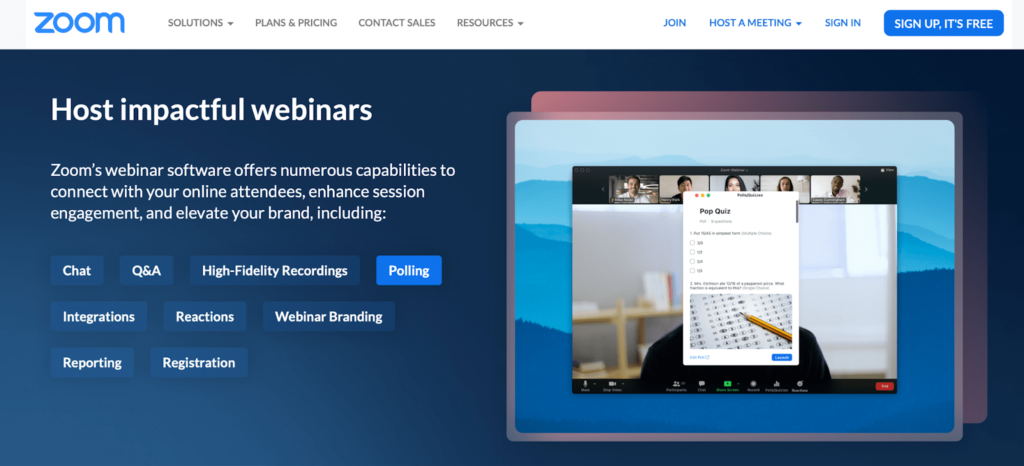
Another good option: ClickMeeting
A close second, ClickMeeting offers all the immersive screen sharing, audience engagement tools, and analytics that educators need—plus a chat feature that translates into 52 languages. Educators can discover additional educational tools with ClickMeeting’s EDU Mode.
If you need webinar software for educational purposes, keep an eye on:
- Moderator capabilities: The moderator should be able to manage attendees by muting, unmuting, inviting people to speak, and kicking users out if needed.
- Audience engagement: How can you make sure your students are paying attention? With audience engagement tools like polls, quizzes, handouts, whiteboards, and live chats.
- Ease of use: can just about anyone easily learn to use this software, including young students and their frazzled parents?
- Accessibility: how easy is it for students to join a webinar? Do they have to download software or just hop on? On the other side of the accessibility question, does the software provide captioning?
- Pre-uploading content: Any class runs more smoothly when videos, slide decks, and files are uploaded before the webinar begins.
Webinar Company Reviews
In the weeks it took our team to comb through webinar companies and figure out which ones met the needs of customers from diverse backgrounds, we discovered which qualities matter the most.
Each of our recommendations satisfies the core needs of webinar customers—and exceeds them. Find out how we determined which criteria to use and how we curated our list of the top webinar companies around.
Livestorm – Best All-in-One-Combo of Webinars and Virtual Meetings
Ideal for both beginners and longtime virtual hosts with fluid needs, a Livestorm subscription gets you both webinar and virtual meeting software without making you purchase each one separately. Even better, Livestorm achieves this without lowering the quality of features and functionality.
While it’s pricier than some of the other options on our list, you can test Livestorm risk-free for as long as you want, although you’ll be limited to 20-minute sessions with a maximum of 30 attendees.
Livestorm’s accessibility is top-notch, too. The software comes with automatic closed captioning and the ability to translate the entire user interface into three different languages. You can also translate the attendee buttons, automated emails, and event room into any one of 24 languages.
A downside with Livestorm is that you can’t record chats, polls, and other audience interactions. But with unlimited recording storage on every paid plan, this is a minor quibble. If you want to sell your webinars later on, Livestorm offers integration with Zapier and your preferred payment processor.
What Makes Livestorm Great
Thanks to this webinar software brand’s versatility, brands both big and small use Livestorm for all of their webinar hosting and video conferencing needs.
You can keep your meetings or webinars small if you want, sending your audience into breakout rooms for collaboration and teamwork. Or you can easily live stream content on YouTube, Facebook, Instagram, and Twitch to reach a wider audience. Livestorm’s analytics give you comprehensive information about your event and your audience—including how viewers found you.
Livestorm supports your marketing efforts by offering software that you can customize completely. Create a seamless brand experience for viewers by using your logo and colors on everything from the registration page to the action buttons to the webinar room and beyond.
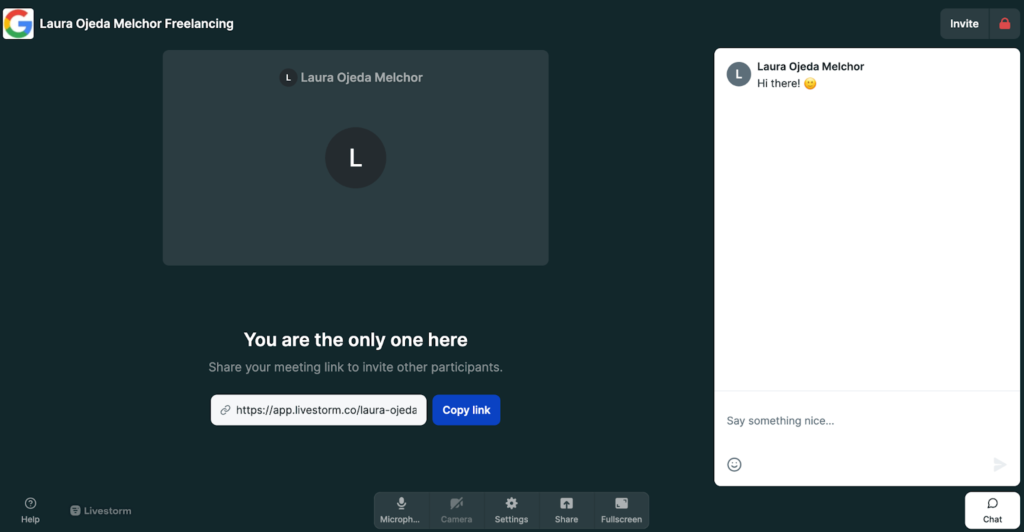
After the free plan, pricing for 100 attendees and four-hour webinar sessions begins at $88 a month billed annually or $110 each month if that’s easier for you to handle. Learn more about Livestorm’s pricing plans.
WebinarJam – Best for Hosting All Types of Webinars
A well-respected software brand, WebinarJam is impressively versatile on its own. But when you combine it with its sister software, EverWebinar, you can run every type of webinar you’ll ever need. WebinarJam makes this partnership easy by offering full access to EverWebinar in three of its paid plans.
If you want to test out different types of webinars, frequently use more than one type, or simply don’t know which type you want to use, WebinarJam allows you to try it all.
WebinarJam’s analytic capabilities surpass the standard, too. Whether you’re running a free educational webinar or a paid recurring event, WebinarJam delivers statistics on audience engagement level throughout the webinar, average time spent watching, show-up rates, replay attendees, and revenue per attendee, if relevant. Finally, the higher paid tiers come with a panic button, though those in the first two plan levels will have to do without.
What Makes WebinarJam Great
In this highly connected world, it can be challenging to find the type of security you need for online events. WebinarJam excels at this, offering either individual passcodes or group passcodes to keep your webinars secure.
If you want to offer streaming, WebinarJam lets you stream on YouTube, Facebook, or WebinarJam Live.
Adding to its versatility, WebinarJam stands out when it comes to scheduling—no matter what type of webinar you choose. Users can adjust time zones to fit their location, minimizing scheduling snafus. You can decide whether to let late attendees join or block them from coming. Enable or disable just-in-time webinars, which pop up as live-simulated events for the user just minutes after signing up.
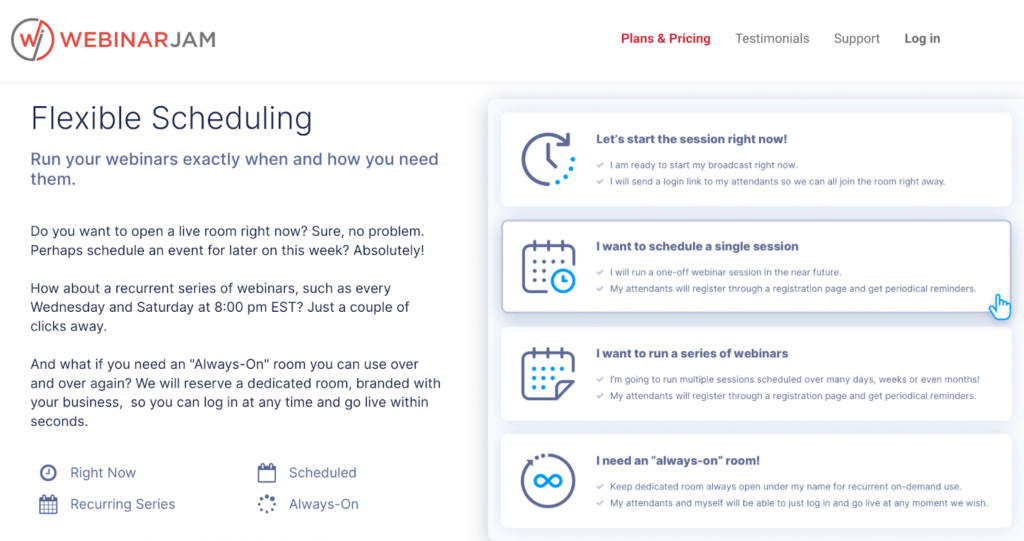
WebinarJam offers a full refund if you’re not satisfied after 30 days of use. Or, if you wait several seconds while you’re on the site’s plans and pricing page, you’ll see a popup promoting a 14-day trial for $1.
After this, membership begins at $39 a month billed annually.
ClickMeeting – Best for Beginners
Learning the ins and outs of webinar software can be time-consuming, but with ClickMeeting, it’s easy. With its budget-friendly pricing and beginner-friendly user interface, ClickMeeting gives you the space to learn how to run webinars at your own pace.
With the basic plan, test out live, recurring, and paid webinars, along with online meetings. The more advanced plans also get you automated, hybrid, and on-demand webinars. All plans include Edu Mode, which helps tailor webinars to educators and students.
We wish ClickMeeting had a green room or backstage chat for presenters to communicate with each other, and it would be helpful if more than just the enterprise plan offered full white labeling. Still, with breakout rooms, lengthy webinar runtimes, and solid analytics, ClickMeeting is a fantastic choice for beginners.
What Makes ClickMeeting Great
We love how ClickMeeting gives beginning users a low-risk place to test out their webinar skills. The lowest pricing tier lets you host 25 attendees, but you can add up to 1,000 if you need to.
ClickMeeting’s scheduling tools are dependable, and the timeline feature shows you all past and upcoming events in an easily digestible layout.
Integrations with popular payment processors, along with tools like YouTube, Facebook, Slack, and LinkedIn, help your webinars go smoothly. ClickMeeting weaves instructions throughout its pages, helping you learn as you go.

Try ClickMeeting for free for up to 30 days. After that, plans begin at $25 a month billed annually. See our full ClickMeeting review for a deep dive into this beginner-friendly company.
Demio – Best for Marketing and Sales
Demio’s goal in life is to help you use webinars to strengthen your brand’s marketing and facilitate sales. The platform lets you host one, five, or limitless concurrent webinars—depending on the plan—to earn you more money for your time.
Run live and recurring events on the entry-level tier, and add automated, hybrid, and on-demand events with the advanced plans. Demio offers screen sharing, but you’ll hardly need it because the brand offers stellar pre-uploading capabilities.
With large CTAs, unlimited recording storage, practice runs, marketing and sales integrations, and 24/7 support with a four-minute response time average, Demio is a must if you need webinars for marketing and sales purposes.
What Makes Demio Great
The biggest strength we found in Demio is its laser focus on marketing. The software exists to help you run profitable webinars with minimal effort on your part.
Demio’s analytics also tell you how much of a webinar each attendee watched, the attendance percentage per attendee, and which handouts each attendee downloaded, helping you find places to improve.
While the entry-level plan comes with limited customization options, the higher tiers allow you to add your logo, colors, favicon, and background color to everything from emails to event rooms.
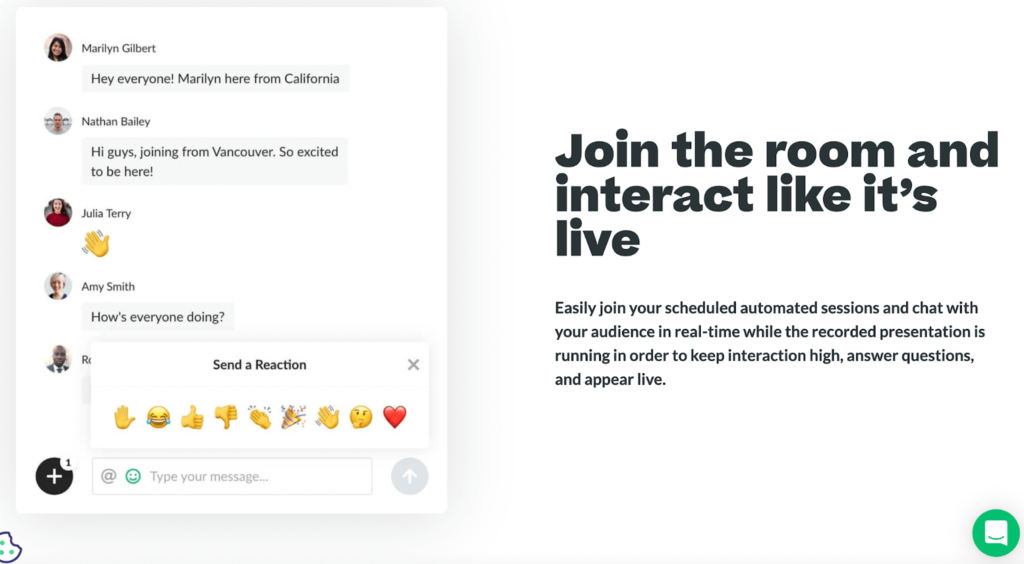
Demio offers a 14-day free trial, after which plans begin at $34 a month paid annually.
Webex – Best for Hosting Accessible Webinars
Most webinar software brands offer at least a modicum of accessibility, but Webex puts it front and center. The brand strives to make webinars and virtual events accessible for the visual, mobility, and hearing impaired.
Keyboard shortcuts and screen reader support help with navigation, while closed captioning, high contrast text, and the ability to integrate interpreters to translate the webinar into both spoken and gestured languages.
Webex lets your audience use different gestures to translate into emojis that help them easily participate in chats and other audience engagement tools.
While you can eliminate Webex branding and replace it with yours, the site makes it difficult to add any type of CTA.
What Makes Webex Great
Powered by Cisco, Webex is powerful when it comes to security and technology. Designed to be accessible for huge virtual meetings, Webex gives you AI assistance during events, is highly reliable, and lets you stream to any platform.
With 24-hour support, easy scheduling, and a 24-hour time limit for webinars, Webex can fill a vital role for companies with huge and diverse audiences.
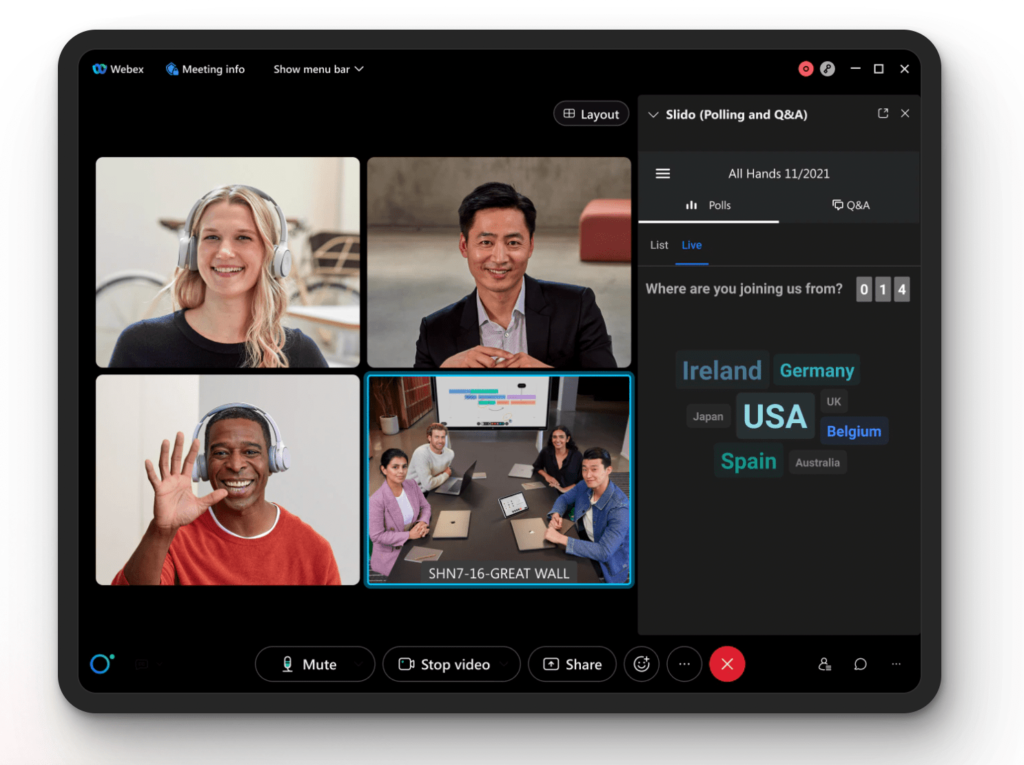
Webex lets you get started with a free basic plan with limited features, and after that, plans begin at $13.50 a month billed annually.
BlueJeans – Best for Scaling Live Webinars Beyond 500 Attendees
Sometimes, you just need to be able to broadcast webinars to an enormous audience—and that’s where BlueJeans comes in. This software allows you to host anywhere from 100 to 500 attendees, growing with you as you scale your brand and grow your audience. If you need more capacity, custom plans offer webinar services for up to 150,000 attendees.
Those numbers may be huge, but BlueJeans offers in-depth analytics and top-notch accessibility features for audiences of any size.
While we love that BlueJeans can get your webinar in front of a giant audience, it’s important to keep in mind that BlueJeans is only good for live webinars. The software isn’t suitable for automated, on-demand, hybrid, or just-in-time webinars.
What Makes BlueJeans Great
Out of all of the options on our list, BlueJeans offers the most room for a growing audience. Its audience limit of 150,000 attendees is nine times higher than average. No matter how large the audience gets, moderators still have control over the event, and attendees all get a unique passcode, making events highly secure.
BlueJeans offers closed captioning in 70 languages, automatic transcription, and simultaneous, real-time interpretation for up to five languages at a time. This expanded accessibility means that you can serve the needs of just about everyone in your audience.
Plus, it has a green room and backstage chat that enable easy communication between moderators and hosts.
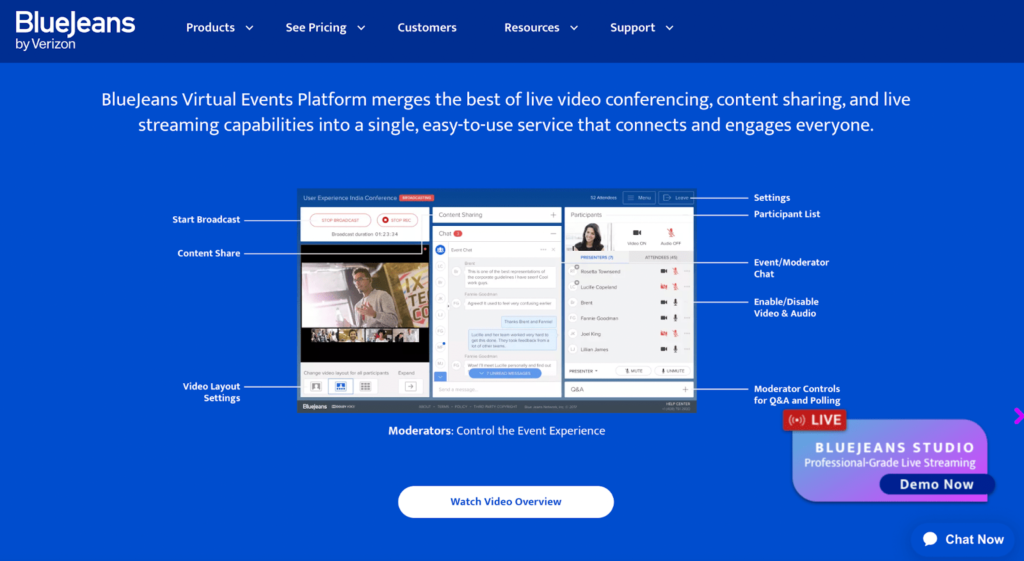
BlueJeans subscriptions begin at $41.67 per month billed annually. Learn more about this brand in our detailed review.
EverWebinar – Best Set-it-and-Forget-it Webinars
If you have a different webinar software option to create live webinars, EverWebinar can take those webinars and turn them into automated events with a live feel.
You can also turn live events into hybrid, just-in-time, or on-demand webinars. What we love about EverWebinar is that viewers won’t even realize they’re not watching a live event: that’s how well the software automates webinars.
The program uses pre-recorded real-time chat, handouts, polls, CTA, and Q&As and runs them through the event, making it seem like it’s happening in real-time. This fosters audience engagement even when you’re not there to host! EverWebinar comes with all the same analytic tools as its sister site, WebinarJam.
What Makes EverWebinar Great
Turning a live webinar into evergreen content is just a click away with EverWebinar. The software also gives you versatile scheduling options and allows payment processing software integration to help you turn your live event into passive income.
You’ll need either WebinarJam or another webinar software to use EverWebinar, but it’s a useful way to expand your audience without doing a bunch of heavy lifting. Because the events are not live, there are no attendee, time, or presenter limits.
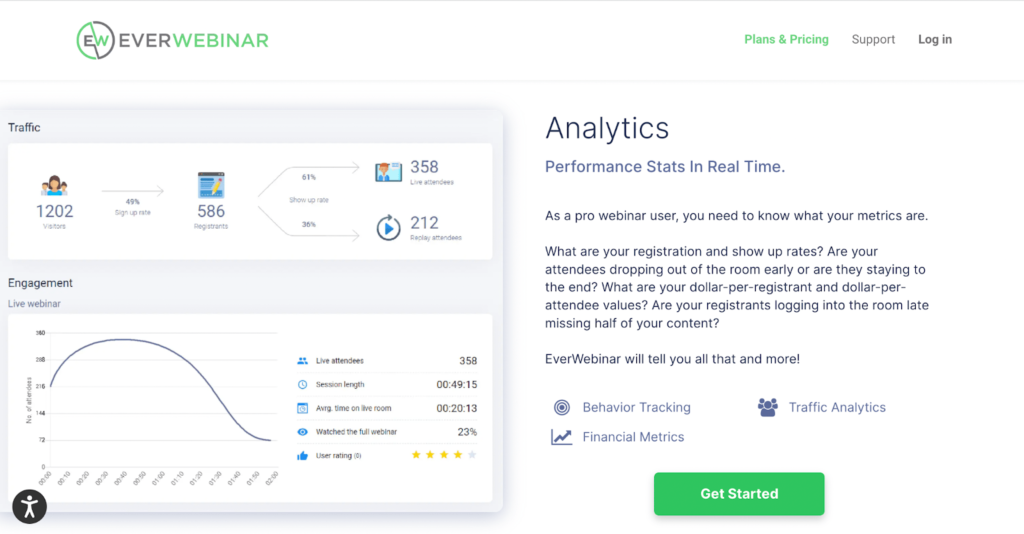
EverWebinar costs $499 a year, but you can try it for $1 for 14 days if you wait a few moments for the pop-up. As with WebinarJam, there’s a 30-day money-back guarantee.
Vast Conference – Best Budget-Friendly Option
If your prime goal is to save money while hosting webinars, Vast Conference is the software that’ll hurt your wallet the least. This does mean sacrificing other features—as the old saying goes, you get what you pay for.
We do like that you can hire an operator to help you run your webinars, although this can get pricey.
Another plus is that you can run entire webinars from your phone, which is something most webinar software does not do! And with backstage chat and green room features, you and your team can communicate in private to make sure the event runs smoothly.
What Makes Vast Conference Great
Vast Conference is four times cheaper than the average cost across all 20 of the qualified brands on our list of webinar software brands. This is significant, especially for companies on a shoestring budget.
Its middle-of-the-road analytics measure audience engagement, attendance, and join and leave times. But remember: this is to be expected from a budget-friendly service. Plus, attendees do not need to download anything to use Vast Conference.
Despite a lower cost, Vast Conference does offer recording. The lowest plan tier gets you one gig of storage but each other plan comes with unlimited space for recorded events.
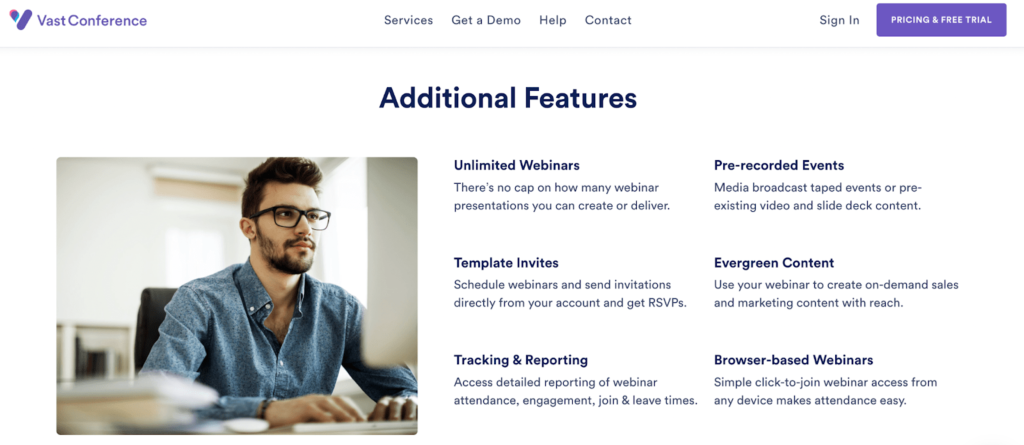
Vast Conference offers a 14-day free trial. After this, plans begin at $11.99 per month when billed annually.
Zoom – Best for Educational Institutions
Ah, Zoom. It’s like an old frenemy that we sometimes love and sometimes don’t, but is always there. And while we don’t recommend using Zoom for all of your webinar needs, we have found that Zoom is the best educational webinar tool around.
Most of our webinar software choices allow anywhere from one to 10 cameras per webinar. Zoom allows 49 cameras on screen at once. This means that if you’re teaching a class and your students are giving presentations, you won’t have to worry about camera limits.
And of all the options on our list, Zoom’s poll, survey, and quiz options are the most sophisticated. Zoom also offers 24/7 support via live chat or chat widget, which is huge if you’re an educator dealing with any kind of technological difficulty. Zoom’s many plans can get confusing to navigate, so you’ll need to poke around a bit to figure out which plan suits your needs best.
What Makes Zoom Great
One of the best things about Zoom is that virtually everyone knows how to use it. Having carried thousands of teachers and millions of students through remote learning during the COVID-19 pandemic, it’s also a tried-and-true format for virtual learning.
Zoom also scores high on accessibility. The software can provide real-time closed captioning and can accommodate sign language translators. Users can change the size of keyboard shortcuts and chat text. The Zoom user interface is intentionally easy to see and use, even for participants with vision issues.
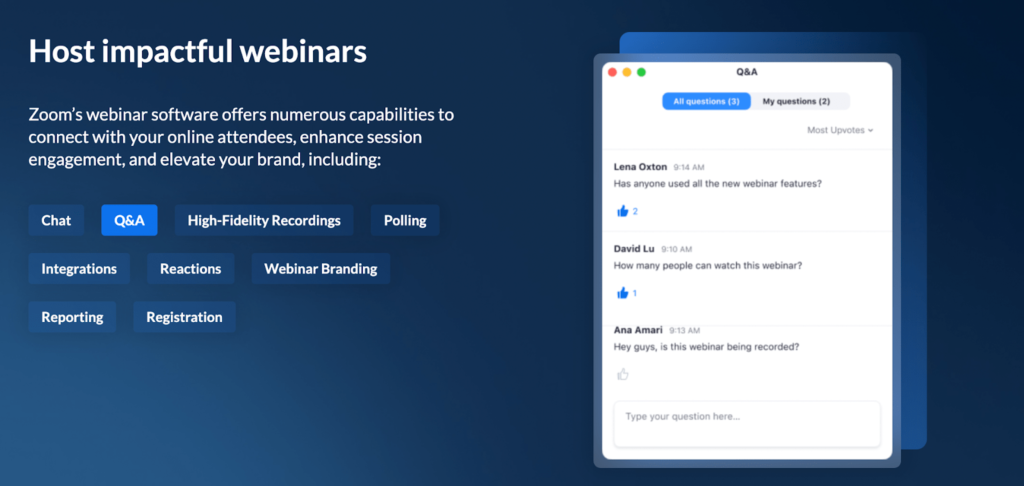
One downside of Zoom is that it’s more expensive than other options on our list. Zoom Meetings can work well for meetings with 100-300 participants. Otherwise, you’re better off with Zoom Webinars, which begin at $79.99 billed monthly for 500 attendees.
Discover more about sturdy old Zoom in our full review.
BigMarker – Best for Large Virtual Events
If you need to run huge webinars on a regular basis, BigMarker helps you host giant conferences and conventions with 100, 500, 1,000, and even up to 10,000 attendees. We love that in the higher-tier plans allow you to customize the entire interface with your brand colors and logo.
The virtual events package lets you create a custom, virtual lobby, expo hall, custom badges, and a network center complete with matchmaking.
Despite being able to scale to thousands of attendees, BigMarker offers excellent analytics with easily exportable data. You can also send large audiences into breakout rooms if you want to weave a more intimate feel through a large event.
What Makes BigMarker Great
BigMarker’s biggest strength is that it lets you host webinars to large audiences without sacrificing the quality of the analytics, marketing features, and integrations.
You can pre-upload polls, Q&As, videos, and slides to help your event run without a hitch. Livestream to LinkedIn, Facebook, and YouTube to share with a wider audience. Create coupon codes and bundles, which you can prominently display to attendees.
Presenters, moderators, and hosts can chat in a private room, which is an important feature for events with hundreds and thousands of attendees. BigMarker also helps you make webinars profitable using the payment processor Authorize.net, but it does keep a percentage of each sale you make.
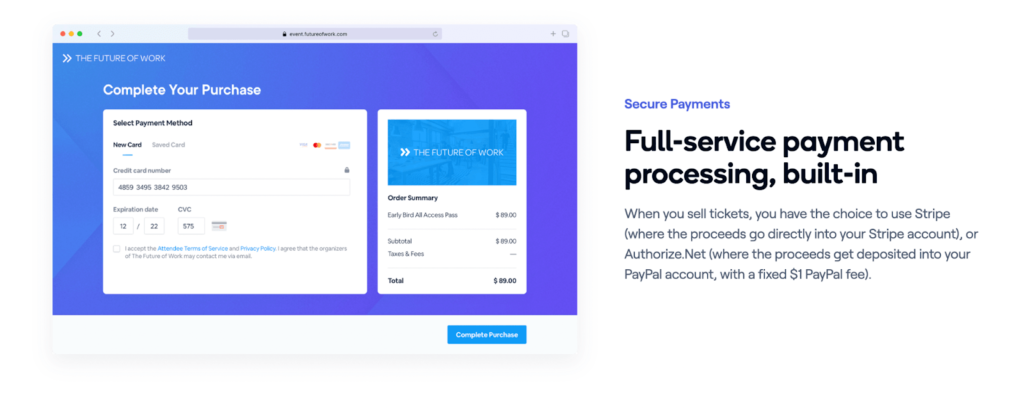
To help you decide whether BigMarker can serve your needs, the platform offers a seven-day free trial. After this, plans begin at $99 a month when billed annually.
Crowdcast – Best webinar platform for a built-in audience
If you struggle to find the right audience—or any audience—for webinars, Crowdcast saves you time and energy because your target audience is already on the site, ready and waiting for a webinar like yours.
Crowdcast is a social platform that helps users find content that interests them, although if you’re running a webinar, you don’t have to depend on a Crowdcast audience finding you. Invite your own audience with a single URL to use for registration, joining the Crowdcast, and watching a replay later on.
Because it’s more of a social media site for webinars, audience members will need to create a Crowdcast account to watch your events. Accessibility is also an issue: if you want to support viewers who are visual or hearing impaired, you’ll have to figure that out on your own.
What Makes Crowdcast Great
We love that Crowdcast is a modern, social media-inspired take on webinars. With Stripe and Patreon integrations, it’s also an easy way to make your events profitable.
Each event gets its own customizable microsite with a countdown, registration info, and share buttons, making it easy for you to spread the word and keep track of who’s coming.
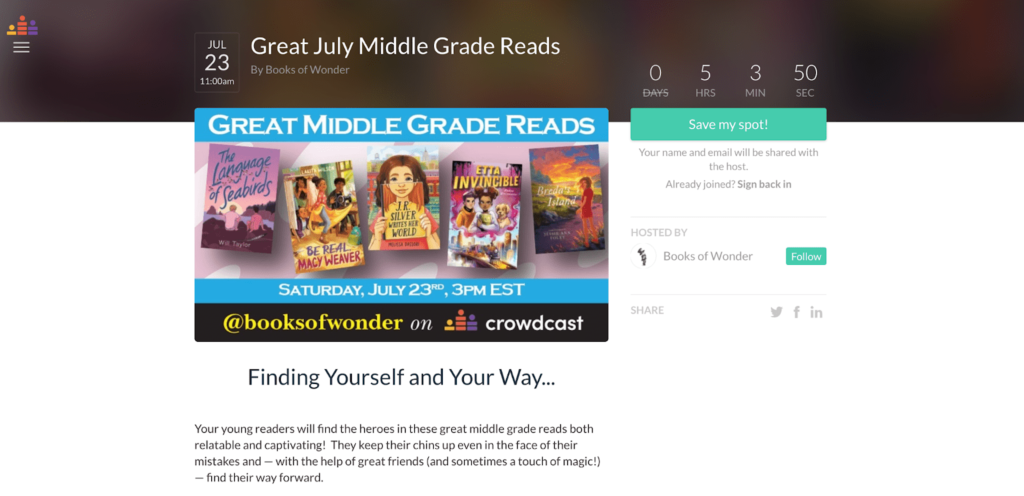
Crowdcast offers a 14-day free trial that’s capped at 10 attendees and 30 minutes of webinar time. After this, pay $20 a month when billed annually to get five hours a month to stream your webinars to an audience of up to 50 live attendees.
GoTo Webinar – Best for infrequent webinars
If you don’t host webinars often, you probably don’t want to pay for a full-service monthly or yearly webinar software membership plan. While GoTo Webinar does offer these, the service that stands out to us is GoTo Webinar Flex.
With the Flex plan, pay only for the webinars you actually host. You’ll pay a small monthly fee to keep your analytics, past settings, accounts, and contacts ready to go for your next event, but you’ll only pay for the actual webinars when you need to host them.
The Flex plan offers all the same features as GoTo Webinar’s full-service monthly plans, and when it’s time to host a webinar, you can pay for up to 3,000 attendees. With Stripe integration, charging for events is a snap.
What Makes GoTo Webinar Great
While we wish GoTo Webinar had an option to add CTAs to events, we do love that you can customize registration pages and webinar rooms with your logo and colors.
Plus, while GoTo Webinar is a standalone solution, you’ll get a free GoTo Meeting videoconferencing software license with a GoTo Webinar account.
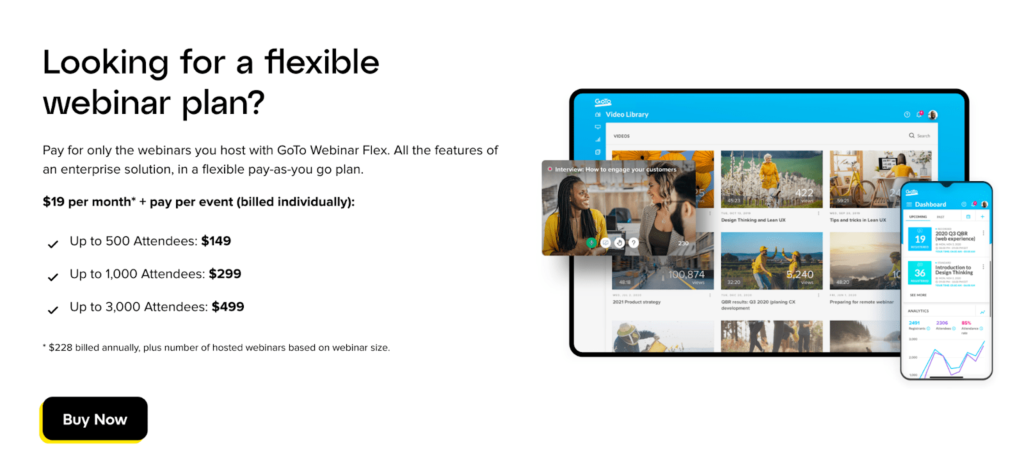
Flex plans are $19 a month billed annually. Pay-as-you-go webinars begin at $149—on top of the monthly price—for up to 500 attendees.
MyOwnConference – Cheapest Way to Facilitate Simultaneous Webinars
Maybe your entire brand relies on webinar events. You find yourself hosting simultaneous webinars all the time, and because you have to purchase an additional license for each host, your costs are spiraling out of control. Enter MyOwnConference.
Regardless of which plan you choose, MyOwnConference lets you host unlimited simultaneous webinars. That’s a unique offering that can help webinar-centric businesses streamline their presentations and save a lot of money.
As a Lithuanian-owned software, though, MyOwnConference’s English copy could be better on the website—which could also use UI updates. And with no option for paid, just-in-time, or hybrid webinars, it’s also limited in the types of events it offers.
What Makes MyOwnConference Great
Affordability is important for many brands, and that’s where MyOwnConference shines. Even the free plan, which limits you to 20 attendees and 20 minutes of recording time, offers unlimited simultaneous webinars.
For just $48 a month billed yearly, you can host unlimited concurrent webinars to up to 150 attendees. Pricing tiers go up according to the number of attendees you desire, but recording times and storage capacity also increase.
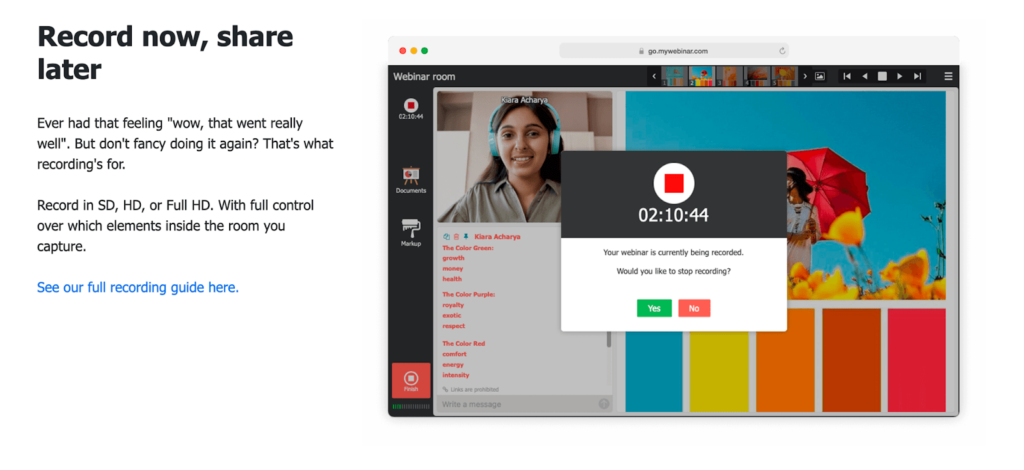
MyOwnConference lets you register for free and test out all their features before committing to the product.
WebinarGeek – Best for GDPR Compliance and/or EU Audiences
When you’re hosting webinars from the EU, GDPR-compliant WebinarGeek is an option that ranks well on best-of lists and comes with an impressive suite of features.
This software comes with easy, reliable scheduling, automatic recording, an array of engagement tools, the ability to pre-upload content, and a low starting price.
One drawback is that there are few reviews to support WebinarGeek’s functionality, but this may be because the company is based in the EU and has a larger audience in Europe than in the United States. WebinarGeek is also missing breakout rooms and accessibility features, which other options on this list include.
What Makes WebinarGeek Great
General Data Protection Regulation (GDPR) compliance is huge, especially because many of you probably host audiences based in the European Union, in which case GDPR rules still apply to you. WebinarGeek helps you follow this aspect of EU laws even if you’re based in the United States.
WebinarGeek also offers live chat and phone support during EU business hours, which can look funky in the United States. But again, much of WebiarGeek’s audience is in the EU. We also love that WebinarGeek offers all five webinar types, including paid webinars, which are made possible with Stripe and Mollie integrations.
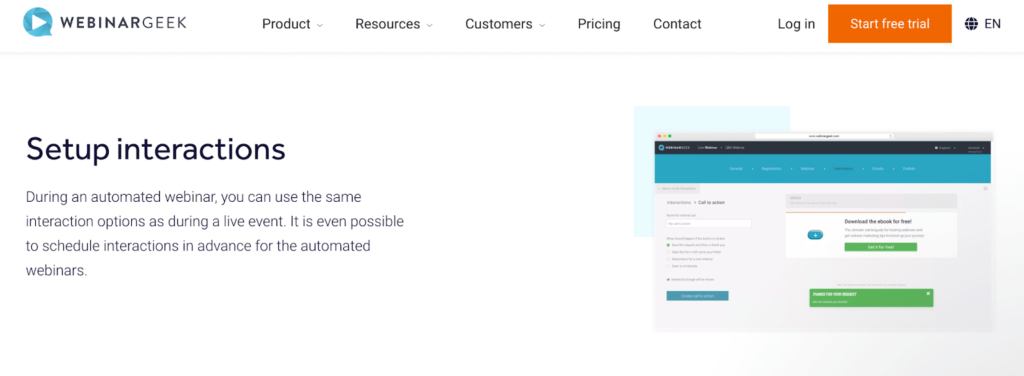
Test WebinarGeek out with a 14-day free trial. After that, plans begin at $19 a month billed monthly.
Quick Sprout Webinar Related Content
If you’re wondering how to start using webinars to improve your brand, or you’d like to dig deeper into the topic, we’ve organized our webinar content links into easily scannable sections below.
No comments:
Post a Comment